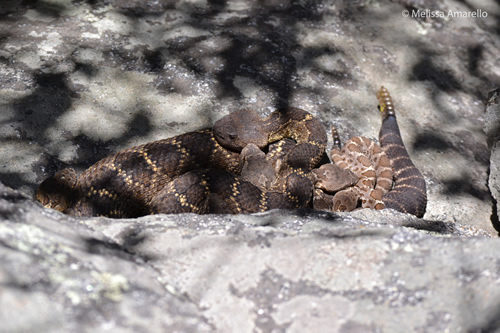How can you cuddle without arms?
Social Behavior in Snakes
Daniel Dashevsky and Patrick Sadil : Biology 342 Fall 2012
| Home | Hibernation | Mating Ball | Rattlesnakes | References | Find the Hidden Snakes | Course Home |
Rattlesnake sociality

Many rattlesnakes hibernate together, much like garter snakes, in burrows known as hibernacula or rookeries. This indicates that hibernation behavior may be a convergent trait among these North American snakes (and possibly many other snakes from temperate latitudes around the world). Pregnant females will stay at the rookery even during the active season. There they give birth and raise the neonates. Individuals will often return to their natal hibernaculum year after year, how they accomplish this has yet to be determined. There is mounting evidence for the existence of social interaction between these snakes, even outside of the context of mating and hibernation.
Evidence for sociality
Clark et al (2012) found that pregnant female timber rattlesnakes (Crotalus horridus) are more related to the other individuals that they aggregate with than one would expect random individuals from the same hibernacula to be. The snakes probably use scent to identify their relatives, but this has not been explicitly proven. Amarello and Smith (unpublished) used time lapse photography to record interactions between individuals at Arizona black rattlesnake (Crotalus cerberus) rookeries. They found that the gregariousness of individual rattlesnakes was significantly more variable than one would expect if their interactions were random. What this means is that some rattlesnakes are consistently more or less social. This seems to indicate that rattlesnake species which communally hibernate also show signs of social interactions.
Examples of social interactions
One particularly interesting event observed by these researchers (Amarello et al 2011) included a pregnant female confront a neonate as they were basking together. The neonate was moving towards open ground, but the female kept it in the shelter where they had been resting. They hypothesized that this may have been to protect the neonate from the perceived threat of the researchers themselves. The following video contains the highlights of the interactions captured by Amarello and Smith's cameras.
Best of Social Snakes from SocialSnakes on Vimeo.
Why should we care?
The reason this research has only been pursued relatively recently is the seeming implausibility of social interactions between snakes. However these findings show that this assumed asociality was born out of unfounded prejudice and the cryptic nature of the social interactions. The same may hold true for many other species. These findings indicate that the impact of social interactions throughout the animal kingdom may have been severely underestimated.
References
Family values: Maternal care in rattlesnakes is more than mere attendance.